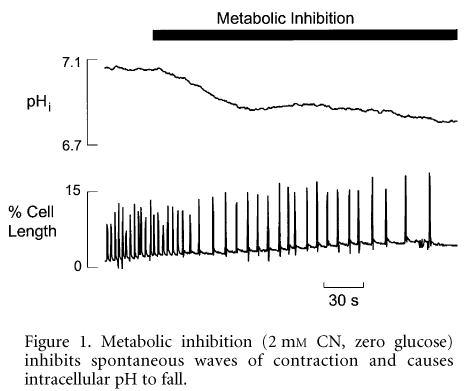When cardiac cells are overloaded with calcium, spontaneous release of calcium ions from the sarcoplasmic reticulum (SR) produces propagating calcium waves. In previous work we have shown that the frequency of occurrence of these waves is decreased by metabolic inhibition and that this is accompanied by an increase of SR Ca2+ content (Overend et al. 2001). These effects were attributed to a decrease in the open probability of the SR Ca2+ release channel or ryanodine receptor (RyR).
The aim of the present work was to investigate the mechanism by which metabolic inhibition decreases RyR open probability. Specifically, we have investigated the contribution of changes of intracellular pH as intracellular acidification has been shown to decrease both the frequency of Ca2+ sparks (Balnave & Vaughan-Jones, 2000) and the amplitude of systolic Ca2+ release from the SR (Choi et al. 2000). Experiments were performed on isolated rat ventricular myocytes. The occurrence of Ca2+ waves was determined from cell length while simultaneously measuring intracellular pH with the indicator carboxy SNARF.
As shown in Fig. 1, the decrease of frequency of Ca2+ waves was associated with an intracellular acidosis. In five out of eight cells this was associated with an abolition of spontaneous Ca2+ release and, in the remainder with a decreased frequency. In order to see whether the acidosis accounts for the decrease of frequency, we have compared the effects of metabolic inhibition with those produced by intracellular acidification (at constant external pH) with butyrate. The results showed that although an equivalent acidosis to that produced by metabolic inhibition did decrease the frequency of waves, the effect was quantitatively less. Complete inhibition of waves was never observed. We conclude that, although intracellular acidification contributes to the effects of metabolic inhibition, something else (perhaps a decrease of ATP concentration) is also important.
All procedures accord with current UK legislation.

